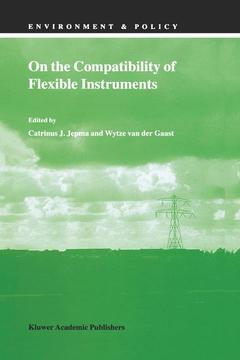Description
On the Compatibility of Flexible Instruments, Softcover reprint of the original 1st ed. 1999
Environment & Policy Series, Vol. 19
Language: English
Subjects for On the Compatibility of Flexible Instruments:
Keywords
Emissions Trading; Kyoto Protocol; Policy; climate change; emissions
Publication date: 10-2012
171 p. · 16x24 cm · Paperback
171 p. · 16x24 cm · Paperback
Description
/li>Contents
/li>
This volume is on the flexibility mechanisms of the Kyoto Protocol and summarises the main fmdings of a two day workshop on 'Dealing with Carbon Credits after Kyoto', organised by ETC and the JIN foundation (both from the Netherlands) in Callantsoog, the Netherlands, on 28-29 May 1998. The workshop was one of the fIrst meetings held on the flexibility mechanisms after the Kyoto Protocol had been accepted at the Third Conference of the Parties (CoP3) in Kyoto, Japan, in December 1997. During the workshop it became clear that during the stage of translating the Protocol provisions on the flexibility mechanisms (notably Articles 6, 12 and 17) into concrete action, there are still many questions on how to interpret the scope and meaning of the Protocol text precisely. Indeed, various issues need to be elaborated on before a full assessment of the future practical work - the start of CDM and JI projects and possibly international emissions trading - can be made. Several issues were addressed at the workshop: e. g. how and via which procedures to determine the net abatement of particular CDMIJI projects; who is liable for non compliance in international emissions trading; is there a need for credit sharing formulae; can incentives be provided for early action, etc.
One: General Overview of Flexible Instruments’ Issues.- 1 Flexible Instruments’ Carbon Credits after Kyoto.- 2 Strengthening the Economy through Climate Change Policies: the Case of the Russian Federation.- Two: The Clean Development Mechanism.- 3 The Clean Development Mechanism: Unravelling the ‘Mystery’.- 4 Creation and Sharing of Credits through the Clean Development Mechanism under the Kyoto Protocol.- 5 An Exploration of Possible Crediting Regimes for the CDM.- 6 Additionality, Transactional Barriers and the Political Economy of Climate Change.- Three: International Emissions Trading.- 7 Towards a Successful International GHG Emissions Trading System.- 8 Administrative and Compliance Issues Related to International Emissions Trading.- 9 Designing a Domestic GHG Emissions Trading System: the Example of Norway.- 10 On Equity and Developing Country Participation.- Four: Compatibility of the Flexibility Mechanisms.- 11 Meeting the Kyoto Commitments using JI, CDM and IET: Opportunities, Risks and Constraints at the Practical Implementation Level.- 12 The Kyoto Mechanisms and the Need for Commercialised Offsets Trading.
© 2024 LAVOISIER S.A.S.




